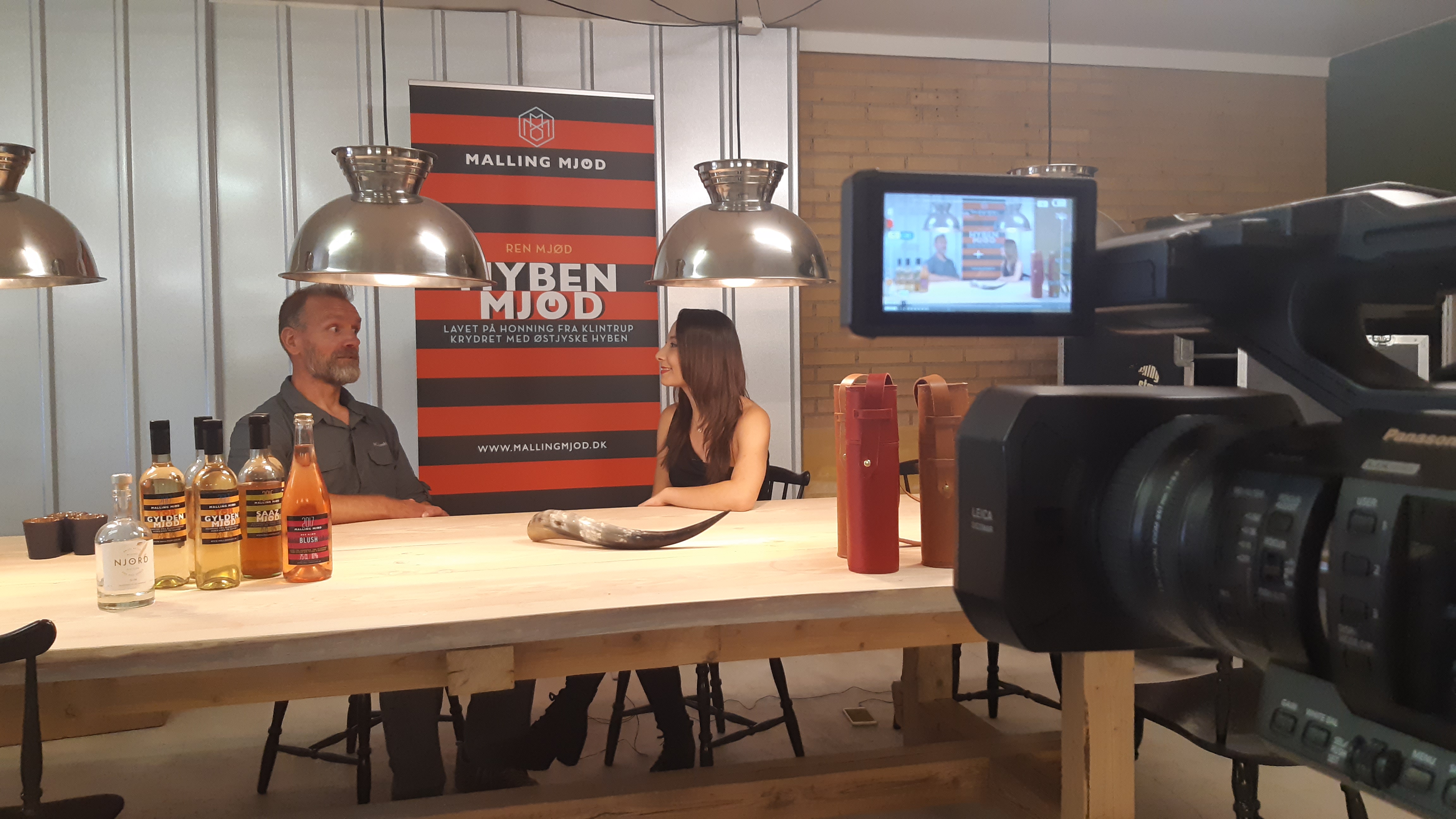Vikings Made A Drink, Danes Perfected It! This Is Malling Mjød
This ancient liquor that characterises for being “sickeningly sweet” among Danes and other Nordic countries presented itself as the perfect opportunity for Michael and Torben to start their own company 8 years ago. Now, they run Malling Mjød, a small brewery that uses local ingredients and provides a dry type of wine that can be paired with food, mixed in cocktails and it’s even traded by weapons within Viking re-enactment groups in the Jutlandic region.

Love Aarhus TV
Just half an hour drive from the centre of Aarhus, the second-largest city of Denmark located in the Jutland peninsula, there is a small, cosy village named Malling. Here, Michael and Torben produced mead or mjød in Danish.
This ancient liquor that characterises for being “sickeningly sweet” among Danes and other Nordic countries presented itself as the perfect opportunity for Michael and Torben to start their own company 8 years ago. Now, they run Malling Mjød, a small brewery that uses local ingredients and provides a dry type of wine that can be paired with food, mixed in cocktails and it’s even traded by weapons within Viking re-enactment groups in the Jutlandic region.
Watch the interview or read the transcription below.
Michael Skjød Jørgensen: When we started we didn’t know anything about mead production, so we went on Google and googled “mead” and we got our first basic, old school recipe for mead and it all started there.
Estefanía Zárate Angarita: How did you start working together on this brewery?
Torben Mølgaard-Andersen: We started in 2011 when Michael called and said, “Torben, we have to make some mead”, and I said, “No”, because mead was a really sticky, dark fluid in my mind, very very, sickeningly sweet. You could drink a glass of it but otherwise… But then I was thinking about it and I said, “Ok, I’ll buy some honey”.
Michael, he bought some of the big glass jars, so he bought a couple of those and cleaned them and I bought the first honey from a beekeeper here in Malling, So I bought 10 kilos from him or something like that… and we started.
E: You are a very niche within a niche company or environment. So why is it so niche that your mead is dry?
M: Well, the traditional mead is sweet, really sweet. We have to be faithful to ourselves here, we don’t like the sweet one so we have to make this wine because this is what we like. We specialise in dry meads but we also do some semi-sweet meads, but not this traditional really sweet ones.
E: So probably the hangover is not as bad…
M: I would say is the same (laughs).
E: I would like to know a bit more about your company…
M: We started in 2011. I am a member of a Viking re-enactment group here in Aarhus and I realised that mead was popular among Vikings. I wasn’t actually into mead at this time because I thought it was too sweet and I didn’t like it, it was too much for me. When you buy this Viking equipment it’s really expensive; I realised that I could trade mead for equipment and then I called Torben and told him, “We have to do this mead because we can use it as a currency”.
E: That’s crazy, that’s amazing! I didn’t even realise there was a group of… how did you call it? A viking…,
M: Re-enactment.
E: What do you do inside this group and what kind of equipment do you trade for mead?
M: Well, the group is a fighting group so we do Viking fighting with swords and axes and spires and, we meet two times a week and we do this fencing, you can call it. You need a lot of gear to be able to do this so that was one I realised mead could help me.
They say that mead is the mother of all wines. It’s a really simple wine, it contains honey, water and yeast, and that’s it, actually. Then you can put berries in it, and herbs and stuff but in its base is just honey, water and yeast. That’s it, you can do it at home.
E: And how are you making it here?
M: Well, we do the same here, we mix the components and then we add herbs and berries but we only use local honey and only local berries and herbs. It’s easier for us to just go out and pick it ourselves than to buy a product, a standardised product in a shop. We take every berry, the small one, the big one, the bad one perhaps because it gives our unique taste when we do it this way.
E: Very Danish taste, probably.
M: Yeah.
***
M: Here in Malling Mjød we are doing a small batch, that means that we are only making around 200 litres a time and we are using plastic barrels like these ones, different styles but soon we will upscale to a 1,000 litres this tanks. It takes a lot of honey to make a tank, around 400 kilos so we are popular at the beekeeper’s house right now.
But let’s have a look in one of these barrels… this one right here is going to be a sparkling mead. You can see that it’s not clear yet, but it will be filtered and it will be put in bottles and hopefully, it will be really nice and sparkling next year. Of course, we can’t call sparkling mead Champagne because… but we will call it perhaps just Sparkling Mead.
The one right here is the more traditional, is in a dark barrel.
This one is the slow cherry, so the wine is dark as a red wine but really a fresh and fruity wine.
And actually right now we are talking a lot about food waste here, in Denmark, and we are in the future going to produce a spirit based on mead product, every time we do a barrel, we will have a waste product. We are collecting these waste products in barrels and later on, we will make it into a spirit. So a spirit made on mead.
A lot of people ask about our Egelund Mjød, the smoky butterscotch mead we do… Is not that romantic actually, because we don’t have oak barrels, we have oak chips like these ones and we use them because is easy for us to control the process. If we put our mead in a barrel, it will get really really intense oaky and undrinkable. This one, when we use these type of smoked oak, we can control the process and we can stop the process when we are certain that the wine is ready. Not romantic but it does the same, it works as an oak barrel.
The oaky mead is this one, Egelund… Ege is actually oak in Danish so it was easy to find a name for this product. A wine that matches sushi and smoked fish.
Right now we use plastic barrels and many people don’t know that about plastic barrels but they are actually micro breathable, so that means that the wine will get a little bit of oxygen and it makes oxidation which is a super thing when talking about mead.
We can make about 5,000 litres a year or 6,000 now with the new barrels but it takes 12 months to make mead here, the minimum so we can’t actually sell that much.
E: How much do you have in stock right now?
M: It’s been a great summer so I guess we have around 600 bottles ready right now but we will be able to make 400 – 500 more quiet fast. We bottle it here, we have really old fashioned and simple machinery to bottle it but we do it ourselves, right here.
This is the smallest bottler you can get. This is really low tech because you just put the bottle on, you put the wine in this container right here and just stick the bottle here and tip it, and then you put the wine into the bottle.
I am lazy by nature. We used to actually fill the bottles in hand, but then we talk about “there must be an easier way to do it”. And we just googled it and we found this one. You can get a lot of really expensive equipment but this was the cheapest you could get, but it does the job.
E: Who is buying your mead right now?
M: We thought we would have a lot of customers among restaurants because we do a wine that could be used as white wine, for example, and our types of mead match a lot of dishes. But we realise now that actually cocktail bars are actually more eager to buy our wine than restaurants so we have changed focus from the restaurants to the cocktail bars instead.
E: What kind of cocktails are these bars making with your mead?
M: I would say avant-garde cocktails, I would say they try to use our mead in more traditional cocktails and they create new ones because this type of wine opens new doors.
E: You’re going to disclose the recipe of a cocktail that you’re launching at the Aarhus Food Festival.
M: We are participating in a competition together with a Danish spirit producer, Njord, produces gin. Together with them, we are competing Stauning, a local snaps firm… against them; who can make the best cocktail.
E: And do you know which ingredients are you going to use in this cocktail?
M: Mead and gin, and that is what I can tell you right now.
Visit http://www.mallingmjod.dk/




